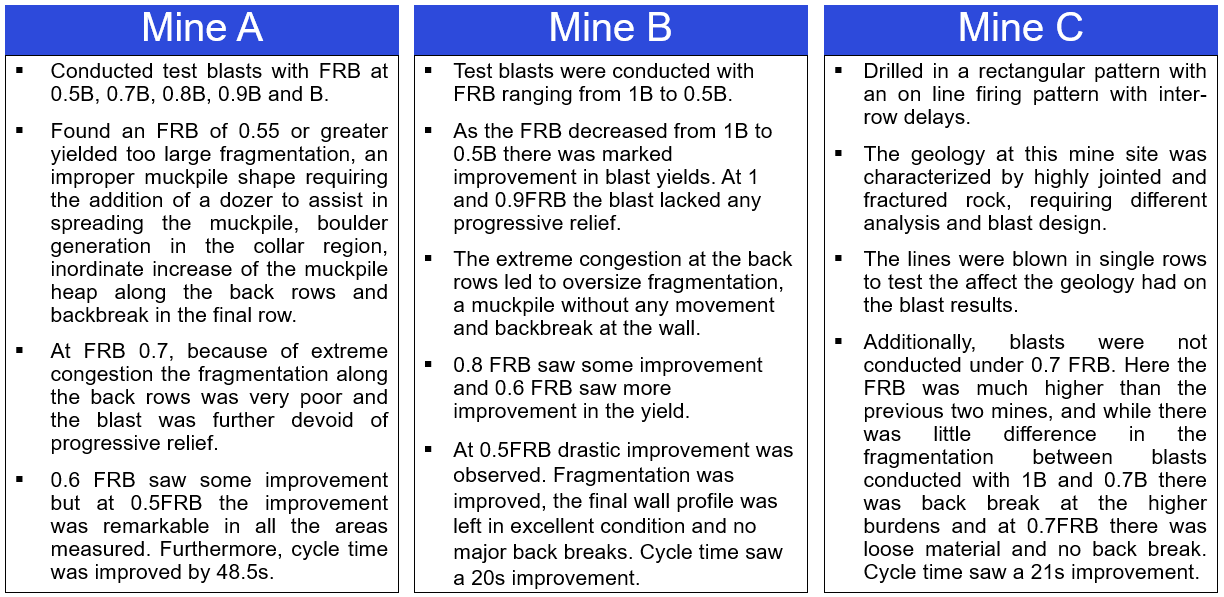Influence of Front Row Burden on Mining
Quality blast designs must take into account the front row burden.
A poorly designed shot plan that fails to take this into account can create numerous problems for a mine including atmospheric overpressure, excessive ground vibration, flyrock, backbreak, and poor fragmentation. These blast designs often require significant additional downstream investment on “clean up” operations.
In a 2017 study on the influence of front row burden, Choudhary and Arora found ”that a front row burden range of 0.50 - 0.70 of designed burden resulted in improved blasting results (fragmentation, Muckpile shape parameters and final wall profile). While, front row burden range of 0.8 - 1 of the designed burden created more congested material, uneven fragmentation and back break in high wall.” (Choudhary and Arora 2017)*
There is no “one size fits all” blast design, rather, blast plans must be specifically tailored to accommodate the differing bench environments and should take into account specific geologies. Careful analysis of the front row burden for every blast is therefore crucial to optimize every blast yield.
Multi row blasts are timed in certain way to allow the material to move to newly created areas of relief. The burden, or the shortest distance from the hole to the free face at the time of detonation, is removed by the explosives. The burden must be correctly analysed and planned for. Too large of a burden has the chance to create excessive ground vibration and a decreased excavation rate of the muckpile. If the burden calculated is too small then the fracturing occurs rapidly and creates air overpressure and flyrock. A study by Rai (2002) concluded that the burden appears to be one of the most crucial blast design parameters for better fragmentation. For multi row blasts the effective burden for each subsequent row varies based on the geology, the pattern, and the timing scheme.
Fragmentation affects not only local productivity and the unit costs of mining, but also the performance of downstream operations including various cycle times such as load time and haul time (through excavator dig time and bucket payload).
Diggability of the blast by the loading machines is a result of the degree of fragmentation, the segmentation and muckpile shape including throw, drop, and lateral spread. Diggability index is the easiest way to track performance.Different muckpile shapes based on changing blast parameters are shown below.
Figure 1: Different Muckpile Shapes based on varying blast parameters
 Choudhary and Arora analyzed the effect of FRB(front row burden) on fragmentation, muckpile shape parameters, and excavator performance at 3 different limestone mines. 1 in Singapore and 2 in India. Choudhary and Arora bottom initiated their blast holes with shock tube systems and mines A and B’s blast patterns were drilled in a staggered pattern and fired on a V-type firing pattern with inter-row delays. The "V-type" shot pattern is also denoted as the chevron timing scheme and for further explanation on how timing and other blast parameters can affect your shot, look no further than the Office of Surface mining presentation.
Choudhary and Arora analyzed the effect of FRB(front row burden) on fragmentation, muckpile shape parameters, and excavator performance at 3 different limestone mines. 1 in Singapore and 2 in India. Choudhary and Arora bottom initiated their blast holes with shock tube systems and mines A and B’s blast patterns were drilled in a staggered pattern and fired on a V-type firing pattern with inter-row delays. The "V-type" shot pattern is also denoted as the chevron timing scheme and for further explanation on how timing and other blast parameters can affect your shot, look no further than the Office of Surface mining presentation.
The improvement in blast results at all 3 sites clearly demonstrate the importance of the FRB in blast design. The decrease of FRB in the shot led to a decrease in the differential burden from bench crest to toe and the properly calculated blast yielded better fragmentation and muckpile movement giving progessive relief on the subsequent shots.
Downstream effects on total cost to mine
Optimized front row burdens have been conclusively shown to improve fragmentation, muckpile shape and movement (including throw, drop, and lateral spread), and equipment cycle times. Optimized front row burden analysis saw a decrease in ground vibration, flyrock, and backbreak. These less than desirable results required additional investment in downstream processing costs including slower cycle times, additional machinery needed, and additional crushing and processing of the material. Explosive crushing is up to 5x more effective than physical crushing and up to 25x more efficient than grinding. Using explosive chemical energy is not only more effective but vastly cheaper as well, for a comparison between traditional crushing circuits and blasting. Keeping all this in mind, a huge efficiency advantage is lost by not optimizing the front row burden- not just the extra wear and tear on the machinery, time investment lost, and man hours required, but also all the additional work that could have been done rather than post blast processing.
Using technology to optimize front row burdens
The technology to achieve better blast exists, most sites today have incorporated drone technology in some capacity, be it for stockpile calculations or generating contours for mine planning. In the same workflow of using photogrammetry to generate contours, a user can also incorporate different software packages to automate the optimization of Front Row Burden calculations. This automatic calculation can be seen visually as well as the input values to generate this Front Row Burden optimization in figure 2. In this example, the software is auto detecting Crest & Toe and analyzing the 3D burden, which looks to find the shortest distance to the face even if it isn't directly straight from the hole, and then takes the user's optimal burden value as a constraint. Either the inclination of the hole or the actual collar of the hole can be changed automatically allowing for a better designed shot.
Figure 2: Automated Front Row Burden optimization by changing the collar of the hole Front row burden is an issue that every mine must account for when designing shots. Blasters can look to use different technologies to automate moving the front row and holes. Gone are the days of designing your shot and then getting to the bench and having to adjust your face holes with just a tape measure measuring from the crest or from information from a laser profiler getting minimal data points. From this information, blasters can alter a variety of factors such as diameter of the hole, loading parameters, and explosive product selection in order to further optimize the blast. The AI can do the optimization for each blast design instantaneously and give the user a 3D interactive model that allows the blaster to “see” inside the rock face.
Front row burden is an issue that every mine must account for when designing shots. Blasters can look to use different technologies to automate moving the front row and holes. Gone are the days of designing your shot and then getting to the bench and having to adjust your face holes with just a tape measure measuring from the crest or from information from a laser profiler getting minimal data points. From this information, blasters can alter a variety of factors such as diameter of the hole, loading parameters, and explosive product selection in order to further optimize the blast. The AI can do the optimization for each blast design instantaneously and give the user a 3D interactive model that allows the blaster to “see” inside the rock face.
Front row burden optimization improves the mean fragment size by up to 25% as well as contributes to a possible 20% reduction in equipment cycle time. Overall huge operational cost savings are accrued when the fragmentation is "As Desired" and it can lead to up to 20% improvement in dig time and approximately 3% improvement in haul production as well as improvement in the unit cost of the material.
Let technology help you design blasts faster and easier that are optimal, safer, and just overall better.

Check out our 2 Free E-books on AI applications for the drilling, blasting, and mining industries to see all the amazing advances that are available.
AI Guide for Drilling and Blasting
AI Guide for Mining
TLDR? Watch our videos instead:
YouTube

